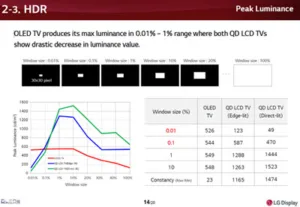In a talk at the recent OLED Summit, Dr. Jang Jin Yoo of LG Display presented research that his company has done that suggests that when the area of a very bright HDR image is very small, as it often is in movie content, OLED TV is much more capable of maintaining its brightness level than LCDs. He presented the following slide:
The table shows that while the OLED maintains the level of brightness when small parts of the display are bright, the LCDs are reduced a lot in brightness.
Analyst Comment
I suspect that the reason for this effect is that LCDs need to avoid halo effects from the backlights, but the data does suggest a good reason why OLEDs tend to look so good in images such as star fields where the total area that is illuminated is small. It also needs pointing out that if you start to extend the level of white beyond 10%, then the brightness of the OLED would fall away and the LCDs would not. It’s more than ten years since Larry Weber presented the results of his analysis of TV programmes that showed that typical brightness of TV content is around 30% APL. However, sports and ‘day time’ TV are significantly brighter than movies which often feature low levels of average brightness, while the highest average brightness was from ‘low cost’ animation, which often has very little black. Weber’s data was used to create the video tests that form part of the IEC power consumption content. (BR)


